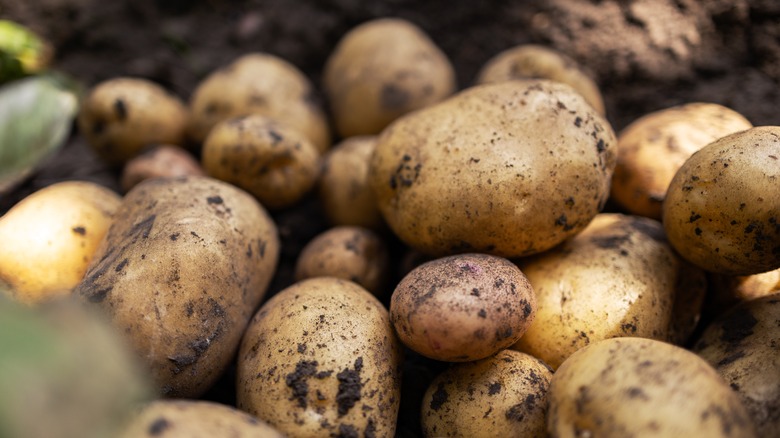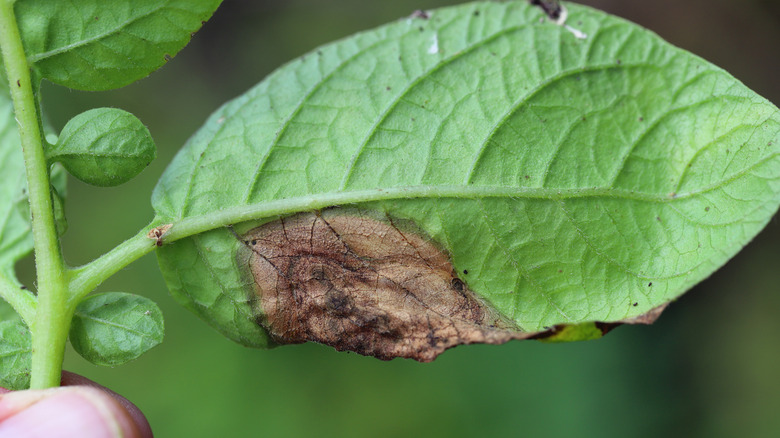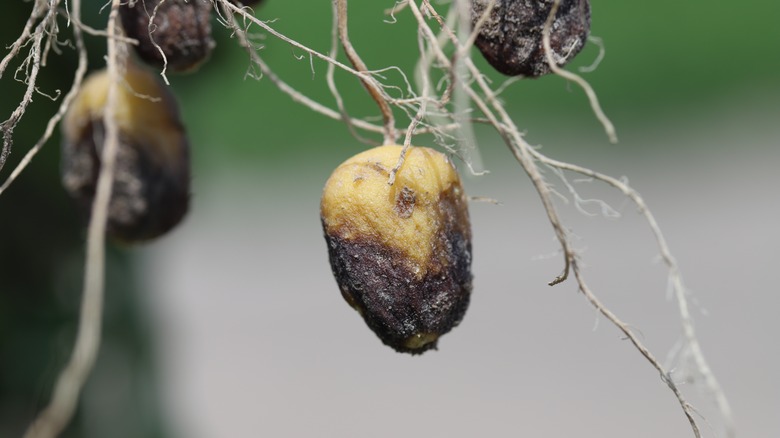One Of The Worst Disasters In Irish History Actually Started In South America
In the mid-19th century, Ireland faced a catastrophe that would become a defining part of its modern history. The Great Famine, also commonly known as the Irish Potato Famine, led to the death of roughly 1 million people and the emigration of 2 million more seeking refuge from the disaster. The famine was precipitated by the widespread failure of the potato crop, a staple food that at the time made up the primary diet of about half of the country's population.
The culprit behind the agricultural crisis was a pathogen called Phytophthora infestans, which results in late blight — a disease causing widespread lesions and rapid tissue death — in potatoes, affecting a couple of the main parts of the plant (both the nutritious roots and leaves). For many years, scientists have been split on whether this pathogen originated in Mexico or in South America before spreading to North America and making its way to Europe. Now, a comprehensive genomic study by researchers at North Carolina State University has provided new insights into the pathogen's origin.
Published in the journal PLOS One, their findings suggest the P. infestans pathogen can be convincingly traced to the Andes Mountains, a result that aligns with historical accounts that indigenous farmers in the area were familiar with the disease by the time of its spread. This revelation not only reshapes our understanding of the pathogen's history, but given the fact that it is still causing problems in crops the world over, it has potentially major implications for managing future epidemics.
Unraveling the pathogen's origin
In the study published in PLOS One, North Carolina State University researchers conducted an extensive genomic analysis to trace Phytophthora infestans' origins. By comparing whole genomes of the pathogen with closely related species such as Phytophthora andina and Phytophthora betacei, which are found exclusively in South America, the team discovered significant genetic similarities among them.
"By sequencing these genomes and accounting for evolutionary relationships and migration patterns, we show that the whole Andean region is a hot spot for speciation, or where a species splits into two or more distinct species," Jean Ristaino, one of the paper's authors told North Carolina State University. "It's one of the largest whole-genome studies of not only P. infestans, but also the sister lineages."
Based on the presence of related species in the region, the highlands of central Mexico were previously considered the strongest candidate for the pathogen's center of origin. However, the team's data showed that the pathogen's migration out of Mexico was relatively small compared to that in South America. While researchers did find evidence of significant pathogen migration into the Andes region from Mexico, this seems to be a more recent trend, whereas, in the past, the gene flow was reversed, starting in South America and working its way up. The complexity of relationships between modern potato blight populations is one of the reasons scientists have been uncertain about its origin, with genetic material from the Andes, Mexico, and Europe blending in recent history.
The future of the potato blight fight
The discovery of Phytophthora infestans' origin has serious implications for both the historical understanding of the pathogen and its relevance to contemporary agriculture, suggesting that previous models for its spread may need revision. Parts of South America, England, and Africa continue to deal with potato blight, and pinpointing its center of origin also means being better positioned to explore biological resistance to it — especially the fungicide-resistant strains that have been popping up in Europe recently.
"In the long run, the way to manage this disease is through host resistance, and [this work shows] the focus on breeding efforts needs to happen back in the Andes," study co-author Jean Ristaino told The Guardian. Those efforts need to be as expedient as possible. With climate change causing increasing drought in the Andes region, potentially blight-resistant potato strains might disappear before scientists even have the chance to study them — a possibility not unlike the worst impacts global warming could have in the future.
The challenge for researchers is now to look for a population of P. infestans that reproduces sexually in South America. Currently, Andes-based populations reproduce asexually (by producing clones), a process that tends to build up evolutionarily unhelpful mutations over time and something scientists don't usually associate with a species' place of origin. That means that until such a thing is found, the definitive origin of the pathogen remains a point of scientific dispute. But if you want to learn more about plant and animal species that move across borders, check out the invasive species wreaking havoc in Indiana.


